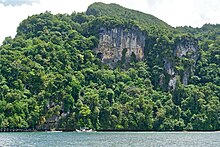Tabon Caves
The Tabon Caves (Tabon Cave Complex) are located half an hour by boat south of Quezon , South Palawan ( Philippines ), in the 130 hectare Lipuun Point Reservation on a narrow peninsula. The cave and grotto system in the karst limestone of former coral reefs comprises 215 caves , so far 38 are archaeologically significant. The complex was named after the chicken-like coastal bird Ibong Tabon ( Megapodius freycinet cumingi ), which often visits grottos.
In order to be able to enter the cave complex, a tourist permit and a guide can be applied for free of charge and unbureaucratically at the city's museum. In the museum there are a few excavation pieces as well as dioramas on the topics of forest, underwater world and native hut. The important excavation pieces are located in the Palawan Museum of the island's capital Puerto Princesa . In the Middle Pleistocene , 175,000 years ago, the sea level was so low that there was a continuous land bridge between mainland Asia and Palawan, an open and inviting gateway to immigration for humans and animals, and this biodiversity corridor was used intensively.
From 1962 to 1970 a team of anthropologists led by the American archaeologist Robert B. Fox came and explored the caves. Among other things, it found the oldest fossil of a modern person ( Homo sapiens ) in the Philippines in the Tabon Cave, which is equipped with large stalactites and stalagmites . The find was initially dated to 22,000 years using the 14 C radiocarbon method ; more recent measurements show 16,500 ± 2000 years.
In addition to the fragment of a skullcap (exhibited in the Palawan Museum of the island's capital Puerto Princesa ) and bone splinters, many other artifacts and relics that go back up to 50,000 years in the past also came to light again. The cave is 41 m long with a grotto-like opening, dry and bathed in bright daylight. It always attracted people well into the Middle Ages and provided shelter.
The excavation site is currently abandoned and archaeological research has been discontinued due to lack of funds. In order not to falsify the results of future excavations, entry is strictly prohibited.
A visit to the Sarang C grotto above, which has not yet been explored, is more exciting. However, it cannot be found without a guide, as it is not signposted and access is only possible through undergrowth and steep climbing sections. Further caves in the area of Iwaig, Kuruswanan, Tumarbong, Taglupa, Kalatagbak in the north of Quezon and Taglumut such as Sarag in the east are waiting to be explored. The Kalatagbak region seems to be particularly worthwhile, where fossils have already been spotted on the surface.
See also
literature
- Robert B. Fox: The Tabon Caves. Archaeological explorations and excavations on Palawan island, Philippines . National Museum Manila, Manila 1970, (Monographs of the National Museum; Vol. 1)
Individual evidence
- ↑ Florent Détroi et al .: Upper Pleistocene Homo sapiens from the Tabon cave (Palawan, The Philippines): description and dating of new discoveries. In: Comptes Rendus Palevol , Volume 3, No. 8, 2004, pp. 705–712, doi: 10.1016 / j.crpv.2004.06.004 , full text (PDF; 370 kB)
Coordinates: 9 ° 16 ′ 47.6 " N , 117 ° 58 ′ 53" E
